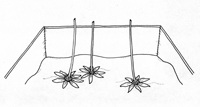In the Landscape
Black-eyed Susans are very showy during the period that they are in bloom, so they stand out in the summer garden. Plant some in the yard to brighten areas where evergreen shrubs dominate. Place them toward the back of a flower bed so that they do not overwhelm smaller plants. Plant them in corners where other plants have difficulty because of poor soil or along walls, fences and in niches that need a splash of color. In large spaces, several clumps planted closely create stunning drifts of golden yellow. While not suitable for windowboxes and smaller containers, Black-eyed Susans will grow enthusiastically in large pots on decks and patios. Be sure to water them regularly, as plants in pots located in bright summer sun dry out rapidly.
 |
Drying
Black-eyed Susans are among the easiest flowers to dry with sand or borax. Pick dry flowers on a clear, low humidity day after dew has dried and before evening dampness. Choose perfect flowers with no holes in the petals or discoloration. Plunge cut stems into warm water immediately to forestall wilting.
Use very fine, clean sand. Place flowers in a container such as a shoe box set face down with their stiff stems vertical. Gently pour sand in and around the blossoms, filling the container and covering the petals completely. Leave the box uncovered to encourage moisture evaporation and provide air circulation. Sand doesn’t desiccate plant tissues, it just supports the flower while it dries naturally.
It will take 3 to 5 weeks, depending on thickness of the petals and the dryness of the atmosphere. An alternative to sand is a medium of 1 part borax to 3 or 4 parts cornmeal. You can also choose to air dry the blossoms, allowing the petals to drop, and keep the black bristly seedheads.

